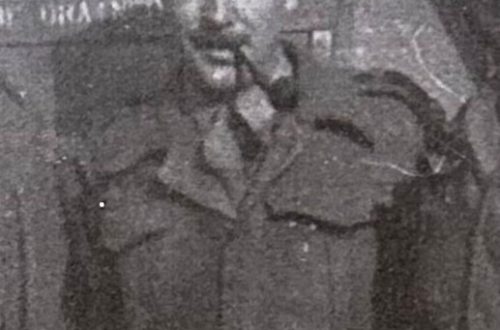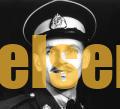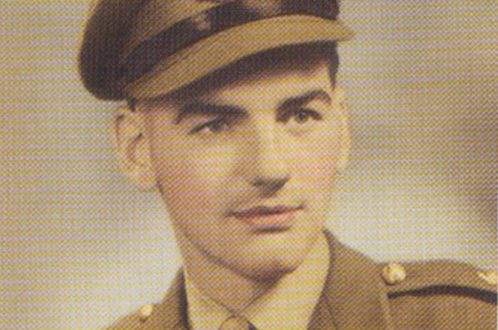
Harold Burgh (REME)
Harold Burgh, World War II veteran and former warrant officer in the Royal Electrical and Mechanical Engineers.
The British veteran, who will be 90 in June, spoke at a Holocaust Remembrance Luncheon April 28, 2014, at the Galaxy Club on RAF Mildenhall, sharing his experiences in the British Army and telling how his unit spent time at Bergen-Belsen concentration camp in Germany right after its liberation in 1945.
“We were there to help distribute what food there was, but there wasn’t a great deal we could do,” he said.
In December 1944, Hitler decided to launch a final counter attack, with the aim of driving the Allies back to the channel ports.
They gathered together every serviceable aircraft, tank, truck and artillery piece, and conscripted males between the ages of 14 and 17 years old.
“On the morning of Jan. 1, 1945 – a date I shall never forget – I was crossing the camp with a colleague, when two low-flying aircraft appeared and strafed our camp from one end to the other, and other units in the area,” Burgh declared. “The instinctive thing to do is to take cover, any cover; the first available cover was a three-ton truck which stood a few yards away, and we dived underneath it and stayed underneath it for what seemed like an age.”
“When the aircraft had gone, we came out and the regimental sergeant major happened to be passing. He said, ‘Have you been sheltering under that truck?’ We said yes. He said, ‘Do you know what’s in it?’ – and he told us it was the unit munitions truck … loaded from floor to ceiling with explosives of all kinds! One stray bullet, and we would have made a wonderful exit from this world – and a magnificent firework display!”
A few days later, the unit received a signal from their headquarters, informing them that an enemy armored brigade was heading in their direction, and was estimated to be about 10 km away.
“My immediate task was to destroy the unit war diary and all other secret and restricted papers,” Burgh said. “Our salvation came from the guards at Armoured Division, who halted the German advance and in the ensuing battle, destroyed four German Tiger tanks. Not for the first time, I felt that somebody up there was looking after me!”
Burgh said their entry into Germany resembled a scene from Dante’s Inferno.
“Buildings were burning fiercely on both sides of the Rhine bridge, shells were landing all around and snipers were very active,” recalled Burgh. “A truck in the convoy just ahead of mine left the road and detonated a land mine, killing all the occupants. We assumed that the night sniper had hit his target.”
Thankfully, Burgh and the rest of his unit began to feel that the end of the war was in sight. Having just crossed a river at the point between Hanover and Hamburg, their unit received a signal from the local German commander requesting a temporary cease-fire, as typhus (an acute, infectious bacterial disease spread by lice or fleas) had broken out in the area.
“At first, we suspected this was a tactic to delay our advance, but it was decided to send officers under cover of a white flag, in conjunction with the Geneva Convention, with orders to report back as soon as possible,” Burgh said.
It was then they came across Bergen-Belsen and its concentration camp.
“I have personal memories of Belsen that are as vivid today as they were 70 years ago when these horrors took place,” the REME veteran said. “Two Jewish chaplains were present and they worked tirelessly, conducting mass funerals with the aid of Royal Engineers and bulldozers. They comforted the prisoners as far as they could, though language was a problem.”
Burgh recalled that German men and women from surrounding villages were brought in to remove the corpses, despite their pleas they had no idea what was happening in the camp.
When Burgh and his unit descended on the camp right after its liberation, they came bearing food for what was left of the prisoners. He recalled vividly how hundreds of them died as a result of eating the food they had provided.
The food included fresh bread from army bake houses and meat products. The concentration camp prisoners’ stomachs simply couldn’t cope after such a long period of depravation. The Allies flew in concentrated food (such as the equivalent of modern-day nutritional supplement or weight gain shakes) once they realized the problem.
“There were no gas chambers in Belsen; prisoners died from starvation, typhus, dysentery or gross mistreatment,” said Burgh. “A vast majority of inmates – though not all – were Jewish; innocents whose only crime was to have been born Jewish or to have had a Jewish background.
“At the end of each day we were required to strip and be sprayed with DEET (strong insect repellent and antiseptic) and wear a fresh uniform to prevent the spread of typhus,” he said. “Seventy final-year medical students from Guy’s and St. Thomas’ Hospital (in London) volunteered to help the overworked medical corps.”
Four of the volunteers later died, having contracted typhus in the camp.
“The entire experience stretched my emotional levels, and I wasn’t alone in shedding a few tears over the futility of it all,” Burgh said. “The sight of the children was particularly distressing, and one I will never forget.”
In April 2005, almost 60 years to the day since the liberation of Bergen-Belsen, Burgh was part of a group of approximately 200 people who traveled to Hanover.
“There were a number of survivors, some liberators, members of the Association of Jewish Ex-Servicemen and Women, veterans, and students from both Jewish and non-Jewish schools, along with a number of teachers accompanying the party,” the veteran said. “One of the ministers who had been at Belsen, officiated at the remembrance service. Entering the camp after 60 years was a very strange and emotional experience.”
He added that on arrival, there were hundreds of people of many nationalities visiting the site.
“Many of the visitors were survivors, and many were from the U.S.A., and they thanked us for giving them back their freedom and their lives,” he said. “The contrast in the camp could not have been more profound; Belsen was now an immense stretch of land covered in heather. There were large mounds of earth – 12 in all – each with a small sign, reading ‘Here are buried 3,000,’ ‘Here are buried 8,000,’ and so on.
“The wooden house that had held the prisoners had long-since been razed to the ground by the army using flamethrowers,” he said.
Following the memorial service, Burgh said floral tributes were laid and everyone lit memorial candles.
“There was a feeling of complete tranquility; it was a beautiful day and the birds were singing. I don’t recall any bird song in 1945,” Burgh said.
13,786 total views




